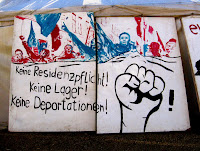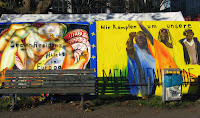I am in Berlin this week for vacation. Since I visited the city briefly many years ago and saw many of the tourist attractions then, this trip will be a mix of some Berlin essentials and other neighborhood tips. I am staying at a hostel in Berlin Kreuzberg, so I am in a great neighborhood and have excellent access to the rest of the city.
Monday, 25 November 2013
I made three major stops on my tour Monday, each completely different from the rest. First, I headed to Oranienplatz, site of Berlin's
refugee camp that has been operating independent from the city since January 2013. Refugees from primarily African countries have been camping out on this major square to protest the EU residency laws. When immigrating into Germany, for example, you have to prove you have somewhere to stay and you have to register with the authorities with an official address. Many refugees, however, do not have an address when they are fleeing their countries; they put all their energy into the flight. Furthermore, many say that the EU cannot force anyone to register an official address. They say it is a human right to live where you choose, whether that be at a permanent address or moving from place to place.
More than protesting, these refugees--none of whom have official addresses--are actively resisting their own deportation. I spoke with two of the camp participants--one from Nigeria and the other from Sudan. They both had been with the camp since the beginning, nearly one year ago. I wanted to ask them what caused them to flee their home countries, but figured they had been through enough without my questions. They told me they can always use donations, whether money or in-kind, and particularly need people to guard the camp at night, when it has the greatest chance of being dispersed by police (or simply when the greatest chance of any violence exists). After talking with the men for a while (I have yet to see any of the women), I packed some flyers in my bag to take back with me to Stuttgart and put a small donation in the donation can. Below are pictures of some of the signs and artwork surrounding the camp.
 |
| "No person is illegal." |
 |
"No residency requirement!
No detainment camps! No deportation! |
 |
Left: "Against residency requirement in Europe."
Right: "We are fighting for our human dignity!" |
No longer than 20 minutes after leaving the camp, a fight broke out between two of the refugees--about what, I don't know. As I circled back around--not on purpose, but due to my less-than-stellar new-city navigation skills--someone had already called the police to mediate the situation. At least six officers arrived at the camp, though surprisingly kept their distance. Four cars were parked in a side street with their respective officers chatting in the middle of the street. Two paddy wagons were parked directly next to the camp. There was far more police presence than the situation warranted and I worried that if the fight escalated, some of the refugees--or all of them--may end up in paddy wagons. Luckily, that didn't happen and eventually the situation was resolved with minimal intervention.
Staying at a safe distance while reorienting myself, I contemplated violence and non-violence in war-torn communities. When people are being murdered all around you, how are you ever going to learn peace? At the same time, there have been people throughout history who have acted as peaceful witnesses to violence. There are probably some of both "types" of characters in Berlin's refugee camp--and many more who fall somewhere along the spectrum. I suspect the two men fighting at the camp belong to the former group and far too quickly turned to violence to "settle" their dispute because they knew of no other way. Who is more at fault? It's hard to say.
There is a significant chance that the camp will be broken up in the next 2-3 weeks. If so, the refugees will be deported back to their home countries and the few media outlets still providing visibility will move onto the next story.
For more information on the camp, see
http://refugeecampberlininfo.tumblr.com,
http://asylstrikeberlin.wordpress.com, and/or
http://www.refugeetentaction.net.
~/~
Deep in thought, I started walking to my next destination: Kastanienalle 86, an occupied house and cultural center in danger of being sold to private owners. In comparison to the refugee camp, the house project is nothing but privilege. The resistance against gentrification pales in comparison to the resistance against deportation. It doesn't even make sense to compare the two. I held the contradictions in mind and continued along to the house.
Unfortunately, the house was closed to visitors when I arrived--or maybe it only opens for public events--so I settled for the next best thing. What else would be next to an occupied house? An anarchist bookstore, of course. I spent a while in the bookstore and ended up buying a book on building sustainable international networks. (I guess I can't poke too much fun at the stereotype when I myself support its perpetuation!)
 |
| Book: Solidarity Spaces & Cooperative Perspectives |
I am not quite sure what to make of Kastanienalle 86. I didn't get to go inside, so I can't judge it fairly. It is in the process of being bought (most likely) and the surrounding neighborhood is quickly filling with trendy boutiques and coffeeshops catering to English-speaking tourists. I would not be surprised if, after a substantial fight, the house is bought. It's really just a matter of time and money. I just hope the socio-cultural projects rooted in the housing collective find new spaces to flourish.
Leaving Kastanienallee, I headed toward my third and final stop of the day: the Ritter chocolate factory. You know the Ritter Sport square-shaped chocolates you can buy at Target or supermarkets in the U.S.? Well, that Ritter is based in Berlin. However, the demonstration workshop was closed for a private event, the "museum" gave only the vaguest ideas of how the chocolate is made, and so I had to console myself in the Ritter chocolate shop. I don't think I've ever seen more chocolate at one time in my life: all different varieties in brightly colored wrappers, and even a meter(!)-stick of chocolate mini-squares were available to be purchased. I picked out a few varieties: nougat, yogurt, almond, and cacao brittle.
While Ritter is not yet certified with the Fair Trade label, they do make some effort to maintain an environmentally sustainable operation and pay their farmers and workers fair wages. They have also recently started a line of EU-certified organic chocolate. I hope Ritter continues in the direction of environmental, economic, and social sustainability: they will most certainly profit from the right decision.
~/~
Monday finished up with Indian food for dinner and planning for Tuesday. On the agenda for Tuesday is: the Brandenburg Gate and surroundings, the Kaiser Wilhelm Memorial Church, and maybe a Christmas market or two.
I leave you with a photo for consideration. I walked past this today. Anyone missing a shoe?
